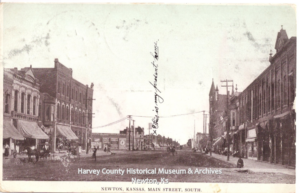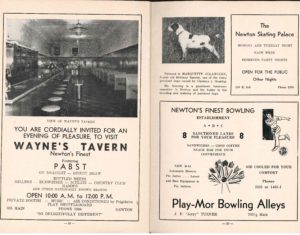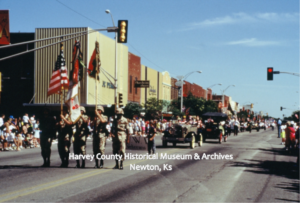by Kristine Schmucker, HCHM Curator/Archivist
Suspicious Death
January 15, 1898, a young unidentified woman died alone in her rented room at the City Hotel located at 413 N. Main. After the coroner was called, it was determined that the young woman was Mary Janke from Lehigh, Ks. While she had been in Newton for several months, not many people knew her. The Coroner discovered in the weeks leading up to January 15, 1898, she had been sick off and on with an undisclosed condition. The two local doctors, W.C. Nolder and James F. Youmans, had been giving her care. They had diagnosed her with peritonitis, an infection of the abdomen that can be life threatening if not treated. Nolder and Youmans also determined this was the cause of death. Coroner James McKee was suspicious and called for an inquest. The investigation that followed captivated Newton for several days with twists and turns.
“Of Delicate Condition.”
During the jury inquiry more details about Mary Janke emerged. She was about 23 and had lived in Newton about a year. Her family lived in Lehigh, Ks. She worked as a domestic and a dress maker with Mrs. J.F. Sims. At first, she boarded at the National Hotel. She later lived with a close friend, Mrs. D.C. Lemert, 122 W Broadway. On January 5, she asked a friend, Jennie Wohlford to get Dr. Nolder, because she was feeling ill. He came to the house on W Broadway and spent time alone with Mary. However, Jennie did not sense anything wrong with Mary after he left. She and another friend stayed with Mary for the night. The next morning, Jennie reported that Mary “looked pale” and “had suffered a good deal” overnight. Mary left later that day, and her friends assumed she went home to Lehigh.
Then, a few days before her death she paid for one week’s board at the City Hotel, 413 N. Main. The very next day she took sick and was confined to her bed. She had sent a telegram to her father and sister in Lehigh to come get her. They apparently ignored her plea thinking she wasn’t very sick. After her death, her brother, Peter P. Janke, came to identify and pick up the body.
“Not what she ought to be.”
At the inquest several witnesses were called. While some found her to be an upright young woman trying to earn an honest living, others said she was “not what she ought to be.”
One witness recalled a conversation he had with a Dave Tennis, another boarder at the National Hotel, who had something to do with her unfortunate history. Tennis, a carpenter with the Santa Fe revealed to the witness that “he had been entrapped by the girl” that Janke was in “precarious condition” and he “was responsible for her misfortune.” Tennis left for Texas shortly after the conversation. Before he left, he gave the witness instructions to contact him if Janke needed his financial assistance.
Others recalled incidents of seeing her coming from Dr. Nolder’s office and that “at odd times she had complained of pains in her side and stomach, for which she had consulted physicians, Dr. Nolder being named mostly.” Another witness, Mr. Shuck reported “that the woman had been sick at sundry times.”
An old friend who saw her the week before Christmas noted “she wore a ‘Mother Hubbard’ and seemed down-hearted and restless as though something were weighing her mind.” Mary Janke kept her own counsel and confided in no one except perhaps her physician, Dr. W.C. Nolder.
Dr. W.C. Nolder was the physician that saw her the most and diagnosed her condition. He reported that he treated her with “hypodermic injections of morphia” to ease here pain. The pain would get better and the return violently. Dr. Nolder said the cause of death was peritonitis. Throughout the inquest, Dr. Nolder was strenuously question by Coroner Dr. McKee.
“An undercurrent that something sensational will yet come to the surface.”
On January 20, the editor of the Weekly Kansan dramatically wrote of the case;
There was an undercurrent that something sensational will yet come to the surface.” (Weekly Kansan, 20 January 1898)
He was not wrong.
Just as the jury was coming to a decision on the Janke case, there was a huge shock to the community.
On January 25, at about 9:30 am, Dr. W.C. Nolder left his office at the corner of 5th & Main and walked to his home on 129 E. 1st, Newton. People that knew him noted that it seemed like he had something heavy on his mind for several days. His wife and two young children were at home, and he complained to his wife of not feeling well. Mrs. Nolder helped him to bed. Just after she left the room, “ the doctor, taking a 38-calibre revolver, immediately shot himself through the head and died almost instantly . . . Mrs. Nolder ran into the room . . .and immediately grew hysterical, and has not been capable of uttering hardly a sane word since that time. She was and is terribly affected by the deed.”
It seemed that there might be a connection between the jury verdict and the suicide. Nolder left a note, but at the request of the family Coroner McKee did not share it with anyone.
Dr. W.C. Nolder was described as a “man vigorous of body and mind. Liberal in all his views; fixed in his ideas of right and wrong, but charitable to a large degree towards those who held views different.” Without the note, the public was left to come to their own conclusions about why Dr. Nolder took his own life and any connection to Mary Janke.
The verdict for Mary Janke’s cause of death was she was in ‘delicate condition for at least ten weeks” and that “criminal practice occurred sometime between January 1 & 15, 1898 by persons unknown.”
Dr. Nolder’s cause of death was self-inflicted gunshot to the head due to temporary insanity.
The events of January 1898 were truly a tragedy.
****No location of burial has been discovered for Mary Janke.
Sources
- Evening Kansan Republican: 19 January 1898, 20 January 189824 January 1898, 26 January 1898.
- Weekly Republican: 21 January 1898, 28 January 1898.
- Hillsboro Herald: 13 January 1887.
- Marion Record: 24 April 1919.
- Peter P. Janke Find A Grave Memorial.
At the end of Dr. Nolder’s obituary, the writer concludes with this sentiment, “May the clods rest lightly on his bosom.” (EKR: 28 January 1898)
He is buried at Greenwood Cemetery, Newton, Ks.
Mrs. Lizzie Bourne Nolder died of pneumonia seven weeks later on a Tuesday, the day her husband died. The obituary concluded, she was “always unusually depressed on that day of the week and had felt that her life would end on Tuesday, as it did.” (Find a Grave clipping Lizzie Bourne Nolder.
































